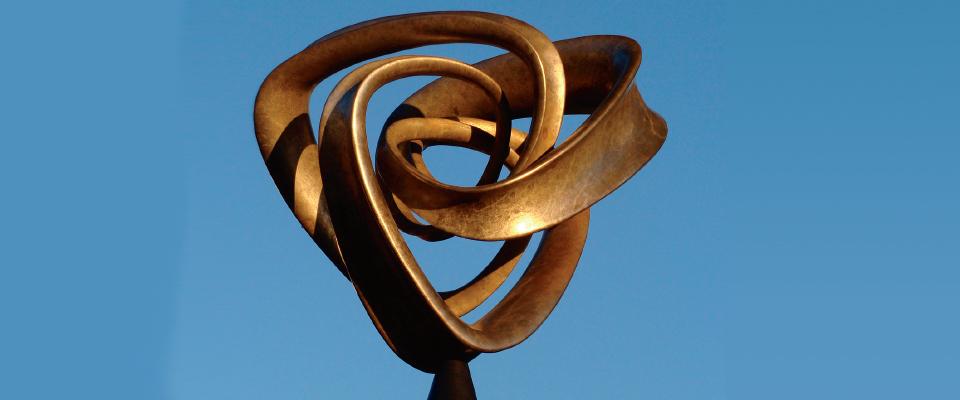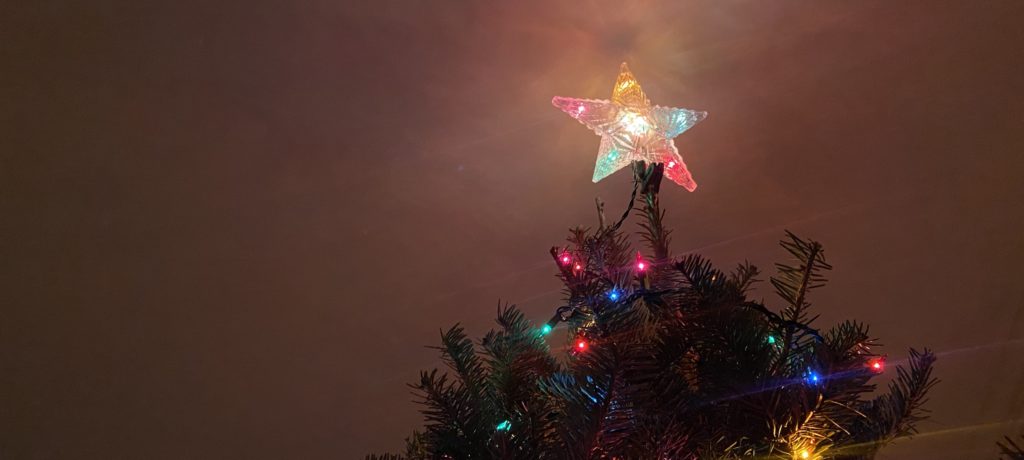A Berkeley professor explores the art of math (and vice versa).
Carlo Séquin lives in a world of impossible objects and mind-bending shapes. Visiting the computer science professor emeritus’s office is like taking a trip down the rabbit hole. Paradoxical forms are found in every corner, piled on shelves, poised on pedestals, hanging from the ceiling—optical illusions embodied in paper, cardboard, plastic, and metal.
The space more closely resembles an artist’s studio filled with works in progress and evidence of past creative excursions than the academic home of an esteemed scientist. That makes perfect sense, though; Séquin is an engineer and also an artist. But he doesn’t just moonlight as one or the other. He is both, simultaneously.
Séquin’s research has contributed to the pervasiveness of digital cameras and to a revolution in computer chip design. He has developed groundbreaking computer-aided design (CAD) tools for circuit designers, mechanical engineers, and architects. Meanwhile, his huge abstract sculptures—collaborations as well as solo works—are permanently installed in spaces such as the H&R Block corporate headquarters in Kansas City, the campus of Missouri Western State University, and on the terrace of Berkeley’s Sutardja Dai Hall, home to the Center for Information Technology Research in the Interest of Society (CITRIS). His pursuits are oddly eclectic on first glance, but there is a winding, twisting thread connecting them all together.
“I fell in love with geometry in high school, and it’s been my game ever since,” Séquin says, his voice filled with delight as he broaches his favorite subject.
That high school, in Basel, Switzerland, specialized in science and math, both areas in which Séquin excelled. A career in the sciences or engineering was clearly in the cards, but as a young man Séquin was also drawn to a very specific kind of abstract art. He was enchanted by the work of Dutch graphic artist M.C. Escher, who pushed symmetry, infinity, repetition, and other mathematical concepts into head-spinning woodcuts and lithographs. He found inspiration in the designs of Naum Gabo, a pioneer of kinetic sculpture; and of Swiss architect, fine artist, and industrial designer Max Bill, who brought a mathematical precision to the geometry of his work. Séquin resonated with the abstract geometric shapes of Alexander Calder’s mobiles. Indeed, Séquin constructed his own spinning forms from ping-pong balls and wire.
After receiving undergraduate and graduate degrees in physics at the University of Basel, Séquin immigrated to the United States to work at the famed Bell Telephone Laboratories in New Jersey during the early 1970s. There, he was part of a team developing charge-coupled devices (CCDs), the core component in digital cameras. CCD image sensors are essentially integrated circuits on which a grid of tiny capacitors converts light into electrons. The earliest prototypes had very few capacitors in the array, severely limiting resolution of the image, and Séquin’s insights into the geometry of the devices enabled more capacitors to be placed on each chip, improving the image quality.
After leaving Bell Labs in 1977, Séquin joined Berkeley’s Department of Electrical Engineering and Computer Sciences (EECS). Just a few years later, he teamed up with David Patterson and their graduate students to tackle a simple new computer architecture: RISC (reduced instruction-set computing). It went against the grain of the semiconductor industry at the time, doling out an increased number of tasks to the software running on the silicon. To succeed, RISC researchers needed to solve the jigsaw puzzle-like layout of a new computer chip packed with tens of thousands of components. The challenge was that the CAD tools weren’t yet up to snuff. So Séquin wrote his own.
“For me, the RISC challenge was all geometry,” Séquin says. “I was switching between making chips, and developing CAD tools that would enable us to optimize placement of the elements on the wafer and routing the connections.”
After the success of RISC, Séquin became the chair of Berkeley’s Computer Science Division in 1980, a position he held for three years. At the time, the division was outgrowing its home in the bowels of Evans Hall. Séquin spearheaded the new building committee, including fundraising and management of what would become Soda Hall. But along with his administrative duties, Séquin took the Soda Hall project as an opportunity to shift his graphics research into the 3D realm. For several years, he and graduate student Seth Teller (now at MIT) hacked away on novel architectural design tools and 3D walkthrough software. Their goal was to simulate how we’d interact with our built environment before it’s built. At the time, though, computers couldn’t handle rendering an entire building at once.
Séquin and Teller’s solution?
“Often both (art and science) are about intense observation and abstraction to obtain a deeper understanding of complex ideas and systems.”
“Hide what you don’t see,” Séquin says. In other words, only images of the building in view or immediately adjacent would be generated. Their clever approach has become essential in delivering the immersive experiences of today’s video games and interactive simulations.
Having spent the bulk of his Berkeley experience in the virtual world of CAD and computer graphics, it was an early 1990s collaboration with mechanical engineering professor Paul Wright, currently director of CITRIS, that brought Séquin’s passions into the physical realm. The College of Engineering had just acquired an early 3D printer, a device that squirted out plastic, layer by layer, to build models directly from computer designs.
In the last two years, inexpensive desktop 3D printers have been hyped as a transformative manufacturing and “maker” technology, but these machines started out large, expensive, and clunky, demanding finicky software for designing the objects. Séquin, Wright, and their students developed algorithms to simplify each step: creation and manipulation of 3D objects on the screen, sharing the designs online, and printing better 3D models. For product designers, CAD tools and 3D printers became a boon for rapid prototyping. For Séquin, the technology was a bridge from bits to atoms. Finally, the complex geometries he imagined could be made tangible.
Séquin had already taught a creative geometric modeling course with a “bent of doing fun stuff.” Séquin and his students used the leftover tubes from empty large-format printer paper rolls to make curious geometric models ranging from fractal trees to Klein bottles (a strange geometrical object that has no differentiation between the inside and outside). The course culminated with an art show in Evans Hall.
In 1994, Séquin stumbled upon an article about Brent Collins, an artist in Gower, Missouri, who carved intricate wood sculptures composed of the same kinds of weird shapes that had always captured Séquin’s eye and mind: saddle surfaces, toroidal loops, Möbius strips, hyperbolic heptagons, and the like. During an initial phone chat, the two instantly discovered that they spoke the same language, even though they approached their work from different points of view. Séquin says he had an “analytical approach,” while Collins “was more intuitive.” It was a good match.
“We’d talk once a week and come up with several good ideas for sculptures,” Séquin remembers. “But it would take Brent weeks to make a model. So I suggested that we bring in a computer as a virtual debugging tool to work out the designs.” Of course, there was no adequate software that provided exactly the functionality they needed. So, once again, Séquin wrote his own, calling it Sculpt Generator 1.
Collins’s friends were wary of the “analog” artist moving his models into a computer and, as Séquin remembers, feared that “talking to such a nerd would suck his creativity dry.” Collins ignored his critics, and he and Séquin have since collaborated on numerous bronze sculptures. But while Collins continues with traditional carving and casting, Séquin has harnessed the power of CAD and 3D printers. Séquin’s own otherworldly sculptures have won numerous scientific art prizes and been featured in mathematical imagery calendars.
“Once I have a simple procedural geometric form in the computer, I can change some of the parameters and make 20 or 30 pieces on the 3D printer that are in the same family,” he explains, grabbing various models to illustrate his point or, if one is not in reach, twisting his hands and arms to represent the forms.
Séquin is now retired, but still very much involved in the College of Engineering. He’s teaching an undergraduate course about the “beauty of knots,” helping students to understand the science of loops and hitches by modeling them on a computer and printing the forms in 3D. He’s also advising a graduate student on a 3D-printed set of modular bricks, similar to Legos but curved so they can be “snapped together into rings and knots to make intriguing sculptures.”
And if you visit the sixth floor terrace in Sutardja Dai Hall, you can’t help but be drawn to a twisting stone tower on a pedestal, designed by Séquin and gifted by one of his former Bell Labs colleagues, Paul Suciu. The sculpture, titled Pillar of Engineering, is based on one of the small 3D-printed models that caught Suciu’s eye in a visit to Séquin’s office.
Art and science may seem strange bedfellows—unbridled creativity at odds with logic and reason. Yet they run on the same fuel: passion, curiosity, and a sense of wonder about the world. Artists and scientists conjure up ideas through vision, intuition, and study, and use myriad techniques to manifest those ideas in the physical world.
“Art and science really have the same origin,” Séquin says. “They are often both about intense observation and abstraction to obtain a deeper understanding of complex ideas and systems.”
In fact, Séquin is currently surveying a variety of geometric sculptures by artists such as Eva Hild, to create a taxonomy of geometric sculptures and “reveal the mathematical laws underlying their forms.” He also recently published a paper cataloging the fourth-dimensional geometries of Klein bottles, helping to bring clarity to deeply complex mathematics. And he printed out his 3D models, once again turning science into art through stunning sculptures that put the most esoteric mathematics right at our fingertips.
David Pescovitz, M.J. ’94, is coeditor/managing partner of Boing Boing, and a research director at Institute for the Future. He has also written for Wired, Scientific American, The New York Times, IEEE Spectrum, and many others. From 2000 to 2007 he was the first ever writer-in-residence at Berkeley’s College of Engineering.




















